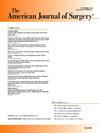钝性胸主动脉损伤血管内修复时机的荟萃分析:早期与延迟治疗的安全性和有效性
IF 2.7
3区 医学
Q1 SURGERY
引用次数: 0
摘要
背景:钝性胸主动脉损伤(BTAI)具有很高的死亡率。胸血管内主动脉修复术(TEVAR)是一种标准的治疗方法。然而,TEVAR的最佳时机仍存在争议。方法检索sembase、Web of Science、PubMed、Cochrane和中文数据库,检索比较急诊(≤24h, n = 4233)和延迟(>24h, n = 1457) TEVAR的研究。meta分析采用Stata 15.0进行。进行亚组分析和敏感性分析。结果在5690例患者(13项研究)中,急诊TEVAR组(n = 4233)的住院死亡率高于延迟组(n = 1457) (OR = 1.99, 95% CI 1.53 ~ 2.58),但住院时间较短(SMD = - 0.30, 95% CI -0.54 ~ - 0.07)。卒中风险相当(OR = 0.89, 95% CI 0.51 ~ 1.53)。急诊TEVAR缩短了ICU和通气时间(P < 0.05)。结论延迟TEVAR可降低患者死亡风险,而紧急TEVAR可缩短住院时间,但未增加卒中风险。不同地区的患者需要量身定制的方案。鉴于在中国人口中没有显著的结果,通过加强资源分配,改善多中心合作和指导是必不可少的。本文章由计算机程序翻译,如有差异,请以英文原文为准。
A meta-analysis of the timing of endovascular repair for blunt thoracic aortic injury: Safety and efficacy of early vs. delayed treatment
Background
Blunt thoracic aortic injury (BTAI) carries a high risk of mortality. Thoracic endovascular aortic repair (TEVAR) is a standard treatment. However, the optimal timing of TEVAR remains debated.
Methods
Embase, Web of Science, PubMed, Cochrane, and Chinese databases were searched for studies comparing emergency (≤24h, n = 4233) and delayed (>24h, n = 1457) TEVAR. Meta-analyses were conducted using Stata 15.0. Subgroup and sensitivity analyses were performed.
Results
Among 5690 patients (13 studies), emergency TEVAR (n = 4233) showed higher in-hospital mortality (OR = 1.99, 95 %CI 1.53 to 2.58) but shorter hospital stays (SMD = −0.30, 95 %CI -0.54 to −0.07) compared to delayed group (n = 1457). Stroke risk was comparable (OR = 0.89, 95 % CI 0.51 to 1.53). Emergency TEVAR reduced ICU and ventilation durations (P < 0.05).
Conclusion
Delayed TEVAR reduces mortality risk, while emergency TEVAR shortens hospitalization without increasing the risk of stroke. Tailored protocols are necessary for patients from different regions. Given insignificant results in the Chinese population, improving multi-center collaboration and guidelines is essential by enhancing resource allocation.
求助全文
通过发布文献求助,成功后即可免费获取论文全文。
去求助
来源期刊
CiteScore
5.00
自引率
6.70%
发文量
570
审稿时长
56 days
期刊介绍:
The American Journal of Surgery® is a peer-reviewed journal designed for the general surgeon who performs abdominal, cancer, vascular, head and neck, breast, colorectal, and other forms of surgery. AJS is the official journal of 7 major surgical societies* and publishes their official papers as well as independently submitted clinical studies, editorials, reviews, brief reports, correspondence and book reviews.

 求助内容:
求助内容: 应助结果提醒方式:
应助结果提醒方式:


